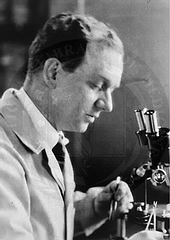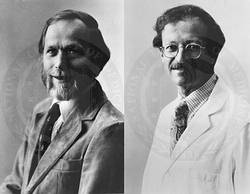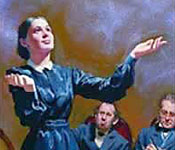Cancer Caused by Germs
The year was 1905. A fund raiser was needed to assist Adventist medical institutions in
getting out of debt. Dr. John Harvey Kellogg, inventor of corn flakes and sundry other foods,
wrote a book entitled Living Temple to serve this purpose. But Living Temple
contained elements of pantheistic philosophy, something akin to New Age teachings, and so it
could not be used. As a substitute, Ellen White donated her book, Ministry of Healing.
On page 313 of Ministry of Healing we read this intriguing statement:
|
Flesh was never the best food; but its use is now
doubly objectionable, since disease in animals is so
rapidly increasing. Those who use flesh foods little
know what they are eating. Often if they could see
the animals when living and know the quality of the
meat they eat, they would turn from it with loathing.
People are continually eating flesh that is filled
with tuberculous and cancerous germs. Tuberculosis,
cancer, and other fatal diseases are thus
communicated.—emphasis added.
|
The above claims that cancer is caused by a "germ," which is some sort of microorganism like
a bacteria or fungus or virus. Of course, it's common knowledge in today's medical and
scientific communities that viruses cause cancer, but it wasn't common knowledge
back then. To illustrate, consider the following:
 |
Francis Peyton Rous
—National Library of Medicine |
| |
| Rous, pronounced rows, Francis Peyton,
pronounced PAY tuhn (1879-1970), an American
medical researcher, proved that viruses cause some
types of cancer. In 1910, Rous ground up a cancerous
tumor from a chicken and filtered out everything
larger than a virus. The resulting liquid
produced cancer when injected into other chickens.
For many years, scientists scoffed at Rous’s discovery.
These scientists believed cancer could not be
caused by a virus because the disease is not
contagious. In 1966, Rous shared the Nobel Prize for
physiology or medicine for his work.—"Rous, Francis
Peyton," World Book Encyclopedia.
|
|
So in 1910, a maverick medical researcher proposed that cancer
was caused by a virus and could be transmitted from
chicken to chicken. He was subsequently derided by
the scientific community for proposing such a
ludicrous idea, and then waited fifty-six years before
being awarded his Nobel Prize. Do you suppose that perhaps
Mr. Rous "plagiarized" his novel idea from Ministry
of Healing?
More importantly, how in the world did Ellen White know that
cancer is caused by an infectious agent?
Cancer Caused by Dormant Oncogenes
| |
 |
J. Michael Bishop & Harold Varmus
—National Library of Medicine |
|
In the year 1864 Ellen White wrote the following statement:
|
Cancerous humor, which would lay dormant in the
system their life-time, is inflamed, and commences its
eating, destructive work.—Appeal to Mothers, p. 27.
|
|
Rather interesting.
"Cancerous humor" is terminology that is a bit antiquated today.
Back then, "humor" typically referred to some sort of bodily fluid. It therefore
appears to us that Ellen White was talking about something other than muscle or
bone, something that had the potential of either remaining dormant or
becoming cancerous after becoming "inflamed."
In 1989, J. Michael Bishop and Harold Varmus won the Nobel Prize for Physiology
or Medicine for their work on cancer. Specifically, they showed how normal genes in
cells could be converted by viruses or chemicals into something that causes cancer:
|
Working with the Rous sarcoma virus,
known to cause cancer in chickens, Bishop and Varmus found that a gene
similar to the cancer-causing gene within the virus was also present
in healthy cells.
In 1976 Bishop and Varmus, together with two colleagues—Dominique
Stehelin and Peter Vogt—published their findings, concluding that the
virus had taken up the gene responsible for the cancer from a normal cell.
After the virus had infected the cell and begun its usual process of
replication, it incorporated the gene into its own genetic material.
Subsequent research showed that such genes can cause cancer in several
ways. Even without viral involvement, these genes can be converted by
certain chemical carcinogens into a form that allows uncontrolled
cellular growth.
Because the mechanism described by Bishop and Varmus seemed
common to all forms of cancer, their work proved invaluable to
cancer research. By 1989 scientists had identified more than 40
genes having cancer-causing potential in
animals.—"Bishop, J(ohn) Michael," Encyclopedia Britannica Ultimate
Reference Suite 2004 DVD.
|
Thus there is indeed something subcellular in the human body that can remain dormant
or can be triggered in a number of ways to become cancerous.
So Bishop and Varmus also won the Nobel prize for their work.
Ambitious scientists out there could take note of this trend.
If they can locate some oddity in Mrs. White's writings that if proven
true would benefit humanity, and if they can find a way to prove it to be
true, they might be able to win a Nobel prize, too.
Give Us Your Opinion
| What do you think of this insight into the cause of cancer? |
| Maybe God told her. That does happen, you know. |
 83.6% 83.6% |
| She should be given a Nobel prize posthumously. |
 7.9% 7.9% |
| Beats me. I don't have a clue how she knew about that. |
 4.4% 4.4% |
| She must have been a super-smart scientist with expensive lab equipment. |
 4.1% 4.1% |
Total Votes: 341
|
|
|



